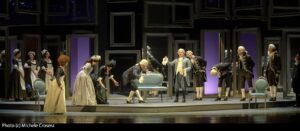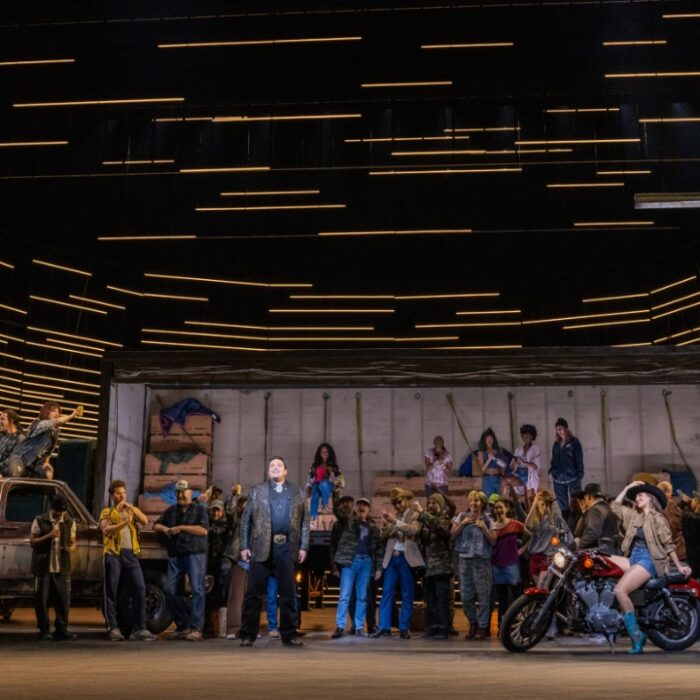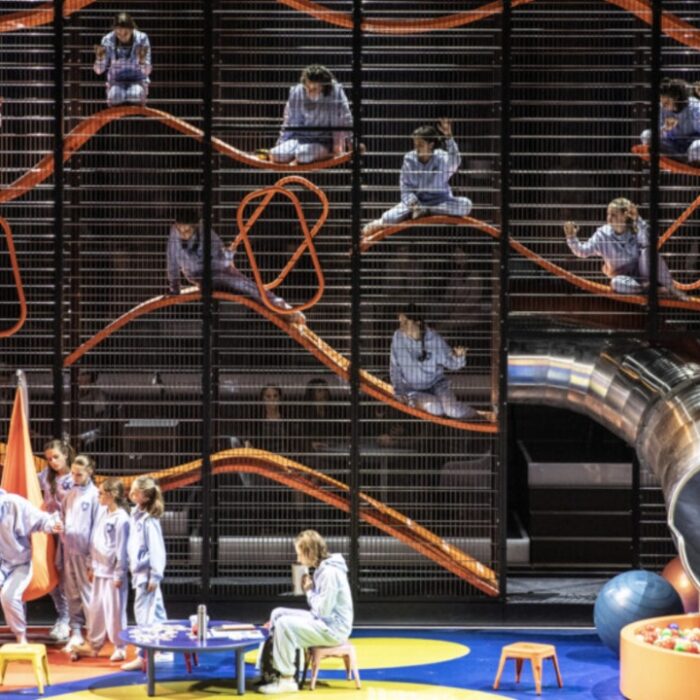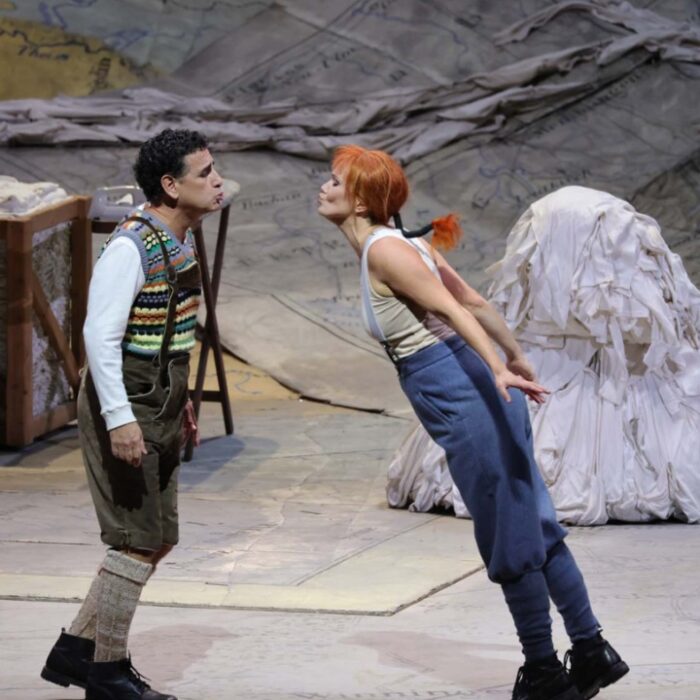
Teatro La Fenice 2022-23 Review: Il Matrimonio Segreto
De Fusco Fails To Capture The Comedy In Cimarosa’s 18th Century Romp
By Alan Neilson(Photo: Michele Crosera)
Premiered in Vienna in 1792, Domenico Cimarosa’s “Il Matrimonio Segreto” proved to be one of the century’s most successful operas, quickly establishing itself across Europe with performances in Milan, London, Barcelona, and Lisbon. In fact, such was its initial success, that not even Mozart, with whom Cimarosa is often compared, was able to create an opera that enjoyed as many performances, with maybe the possible exception of “Cosi Fan Tutte.” Its popularity endured throughout the 19th century and continued to notch up performances. Verdi declared it had “everything a comic opera should have.” The famous Austrian critic and musicologist, Eduard Hanslick, described the opera as “full of sunshine… …(with) a genuine golden color, which is the fitting one for a musical comedy.” Other critics have referred to its exuberance and spontaneity.
Unfortunately, such descriptions could not be used for the performance at Venice’s Teatro La Fenice.
The opera, set in 18th-century Bologna, is based around a secret marriage between Carolina and her father’s servant, Paolino, which acts as the mechanism that moves the drama along. Her father, Geronimo, wants her to marry a count so as to increase his family’s status, but being already married, she is having none of it. Add in her sister, Elisetta, who is desperate to marry the Count, who is not at all interested in marrying her, and Fidalma, her father’s sister, who wants to marry Paolino, and everything appears to be set up for a fast-moving romp with plenty of potential for comedy.
De Fusco’s Direction Fails To Bring Out The Comedy
Yet it did not materialize. On the contrary, it was unimaginative, slow-moving, and occasionally static. Even scenes in which the comedy was crying out to be given its head passed by with hardly a titter from the audience. Part of the problem was due to Giovanni Bertati’s libretto, which even at its original premiere received much criticism. Mozart’s librettist, Da Ponte, referred to Bertati as “a frog blown up with wind,” and another fellow poet commented, “The music is marvelously beautiful, but the words fell below expectations and everyone is dissatisfied…” To be fair to Bertati, however, the libretto is well-shaped. It may not develop multi-layered characters with deep-seated motivations, but the plot line is clear; it possesses clearly crafted scenes with easily recognizable stock characters that have the potential for comedy, and it has managed to entertain audiences for over 200 years.
The main responsibility must lie with the director, Luca De Fusco. Even in his program notes, he showed little faith in Bertati’s libretto, stating that the opera’s long-standing success was due to “Cimarosa’s extraordinary music… …what makes (it) so special is the Neapolitan composer’s melodies.” When asked if the libretto played a role in the opera’s success, he replied, “I wouldn’t say so.” It was an attitude that was reflected in his approach. He appeared happy to let the music carry the drama on its own with little effort made to exploit the potential of the libretto. His one major intervention was his use of projected images onto mirrors in order to reflect what the characters were thinking, possibly unconsciously, behind their words. In Geronimo’s aria “Udite, tutti udite,” for example, in which he sings of his happiness at the prospect of Elisetta’s marriage to the Count, the mirrors reflected images of money. Often, however, the images were semi-pornographic cartoons that reflected the real conversations taking place behind the words.
The use of images to reflect the unconscious is becoming an increasingly common device used by directors: sometimes they add a new dramatic dimension or provide an insight into the work, occasionally they are unfathomable; but in this case, they did little more than state the obvious, and in Act two, they became somewhat irrelevant as there was little to add that had not already been made clear in the first act. Certainly, they were not used for comedic purposes. In fact, De Fusco made little attempt to promote the comedic possibilities at all other than by exaggerating stereotypical reactions, such as an over-the-top swoon when receiving slightly shocking news. As the opera progressed, so the longeuers increased.
There were, however, positives to De Fusco’s reading. By retaining the 18th-century setting, the staging possessed an elegant balance and gracefulness with a pleasing aesthetic. This was in large part due to Marta Crisolini Malatesta, whose traditional costume designs sat easily on the eye as well as reflecting the social status of the characters. The set consisted of a backdrop of mirrors and mirrored doors. Props were restricted to little more than a few period chairs. Everything was colored in shades of blue, black, and white. Whilst each individual scene was beautifully crafted, the stage’s unchanging nature, however, eventually added to the sense that little was happening.
Casellati’s Direction Lacks The Necessary Sparkle
Alvise Casellati’s direction of the Orchestra del Teatro La Fenice did little to enliven the presentation. While, for the most part, he elicited a pleasing rhythmic quality and strong dynamic contrasts, it rarely rose above the workmanlike. Generally, the reading lacked sensitivity and, at times, was a little too heavy, which compromised the necessary delicacy and gracefulness essential for bringing out the full beauty of Cimarosa’s score. There was also insufficient clarity, so textural colors were occasionally muffled. Of course, there were also some fine moments: Paolino’s aria “Pria che spunti in ciel l’aurora,” for example, was beautifully rendered, with Casellati capturing its delicacy and emotional strength, which proved to be one of the evening’s high points. Overall, however, the necessary sparkle was only intermittently present.
A Committed Cast Rescues The Performance
The cast produced a strong, fully engaged performance and made the most of a staging that failed to fully exploit the comedic misunderstandings that keep the plot rolling along. Each singer produced a clearly defined character, which created depth, and they did their utmost to generate the necessary comedy. All sang well, which ensured that ensembles were vocally lively affairs, if visually somewhat static.
Soprano Lucrezia Drei produced a plucky performance as Carolina, whom she portrayed as combative, passionate, and energetic. Her singing was wonderfully expressive to the point where she would occasionally sacrifice elegance and beauty, which ensured that the recitatives were dramatically strong and engaging and that her aria and ensemble parts were emotionally convincing. Her voice displayed an innate lyrical quality, an attractive timbre, and the facility to move the voice flexibly without loss of quality, which she used successfully to define her character. The first act trio “Le faccio un inchino” with Elisetta and Fidalma, in which she locked horns with her sister in an animated and childlike squabble while her aunt acted as peacemaker, was nicely done, allowing her to indulge in heavy mockery and mimicry, which shone a light on the real comic potential of the opera.
Tenor Juan Francisco Gatell produced an excellent portrait of Paolino. Always deferential to Geronimo and lovingly devoted to Carolina, he also successfully captured the anxieties, concerns, and insecurities that dominated his thoughts. His singing was detailed, delicately wrought, and elegant.
Mezzo-soprano Martina Belli produced an authoritative yet very human portrait of Fidalma, who retains her dignity despite being made to look foolish when she finds out Paolino is already married. She possesses a very attractive voice, characterized by a vocal palette of rich, dark colors that enables her to imbue her singing with emotional depth and variety. The voice is resonant and agile, although on occasions it can sound a little heavy in lighter passages.
The character of Geronimo, the father of Carolina and Elisetta, was set up perfectly to be used as a foil in various comic situations. De Fusco, however, simply did not make full use of the many opportunities afforded by this character. The fact that he is almost deaf is an obvious example. Bass Pietro Di Bianco, who played the role, however, put in a good performance, capturing Geronimo’s dignity in the face of the chaos unfolding around him. He possesses an attractive, nicely weighted voice, which he used intelligently to give his character a clear profile. His singing of his opening aria “Udite, tutti udite” was particularly well-delivered and showed off his vocal characterization to good effect.
Soprano Francesca Benitez essayed the part of Carolina’s sister, Elisetta, whom she convincingly brought to life with a well-acted and beautifully sung performance. She possesses a light, bright voice that gives her voice a youthful, fresh sound, which was perfectly suited to the role. Her singing displayed agility and control that allowed her to indulge in quick-fire patter, leaps, and intricate passages of ornamentation and coloratura, which she displayed impressively in the aria “Se son vendicata.”
Count Robinson is another character that contains comic potential. Once again, this aspect was largely bypassed. Baritone Omar Montanari used his commanding stage presence to give the Count a noble gravitas, if occasionally with a very slight comic edge. His singing was clear and vibrant and his intonation precise. Recitatives were expertly developed to bring out their full meaning, while his aria and ensemble singing were beautifully rendered, displaying a fine degree of detail.
Notwithstanding the fine singing of the cast, this was a production that disappointed. De Fusco’s direction was misplaced; “Il Matrimonio Segreto” is not an opera that lends itself to interpretations that are not centered on the comedy and the idea of drawing attention to the fact that there exists a difference between people’s words and what they are really thinking or even their unconscious motivations was unable to compensate for this decision. There was certainly no sense of Hanslick’s “golden color” in this production, and Verdi may have struggled to justify his comment that it has “everything a comic opera should have.



